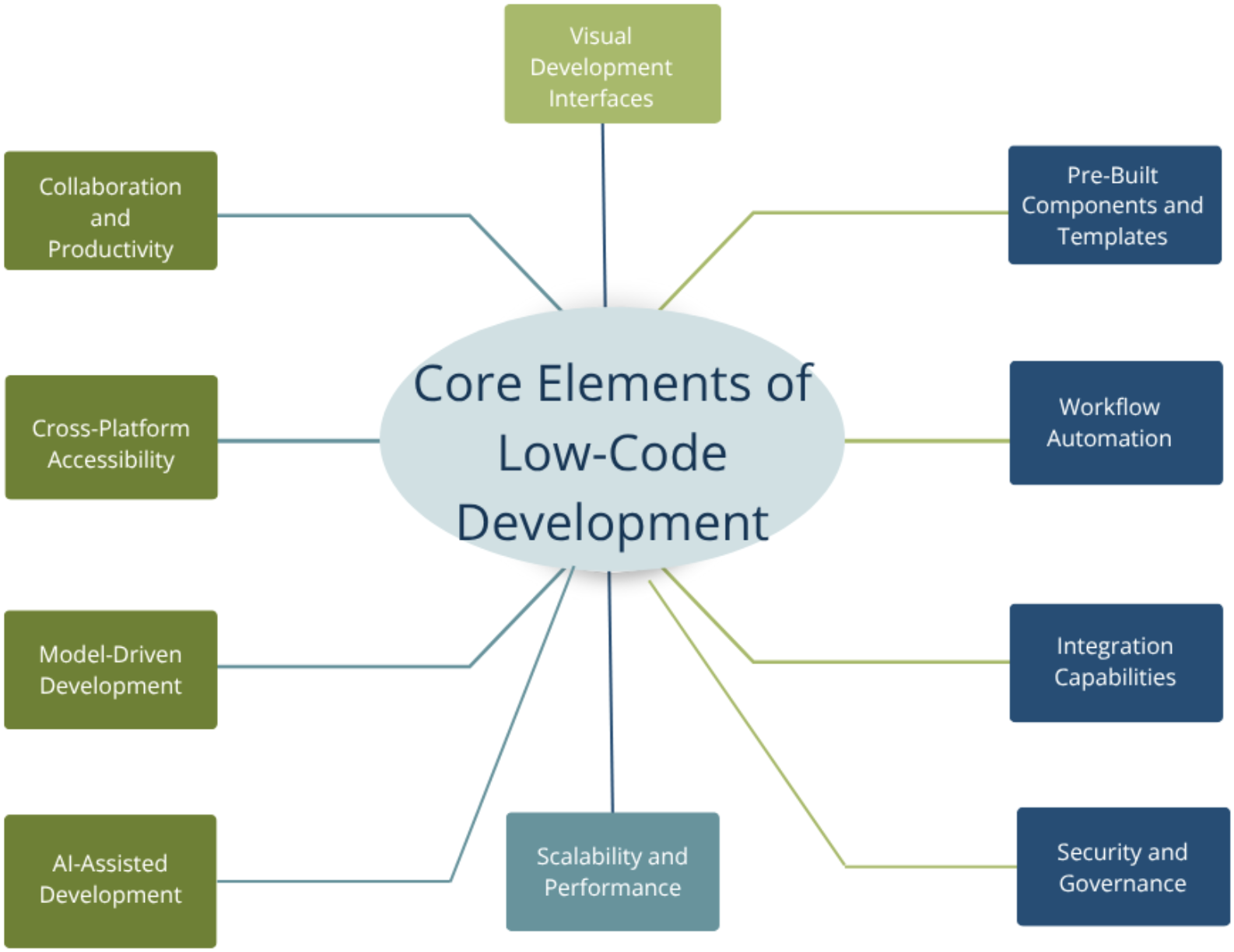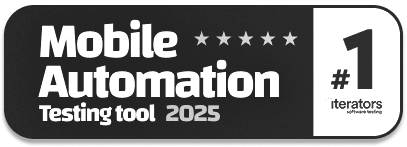Low-Code Development: Core Concepts
|
|
In this age of digital transformation, the demand for rapid application development has skyrocketed. Traditional software development approaches are powerful, but they lack speed, flexibility, and scalability, especially in situations where business needs evolve faster. This is exactly where the low-code development comes into play!
Low-code development empowers developers and non-developers to build applications rapidly using graphical user interfaces (GUIs) and configuration instead of coding. Low-code platforms streamline the development process by using visual interfaces and prebuilt components.
| Key Takeaways: |
|---|
|
We will learn the following from this article:
|
This article explores the core concepts of low-code development and acts as a low-code guide for readers willing to utilize low-code development for modern application development.
What is Low-Code Development?
Low-code development is a software development approach that minimizes manual coding through visual interfaces and a set of tools, thus simplifying and accelerating application creation. Low-code platforms enable rapid application delivery with minimized coding. They allow users to drag and drop components, configure logic through user-friendly environments, and connect services.
This development uses visual development environments, pre-built templates and components, and automation to build applications. It is ideal for professional developers and technically inclined business users (aka citizen developers).
Remember, Low-code is not “no-code”!!
In no-code development, business users have zero programming experience, while low-code platforms still allow users to include custom code when required.
Key Components of Low-Code Platforms
Here are some of the key components of low-code development platforms:
- Visual Programming: This type of programming offers a drag-and-drop feature to design applications, data models, and workflows. The underlying complexities are taken care of, and accelerated development is ensured.
- Prebuilt Templates and Components: Low-code development platforms use reusable modules and templates to speed up development. Most low-code development platforms are built with reusable forms, templates, widgets, and UI elements that reduce the need to develop each component from scratch and increase consistency and speed.
- Integration Capabilities: Low-code platforms easily connect with existing systems and data sources and even integrate with third-party tools.
- Extensibility via Code: Manual coding is minimized, but most platforms support custom scripting for specialized needs.
- Deployment and Monitoring Tools: Low-code development platforms have built-in CI/CD tools and dashboards that allow applications to be deployed, managed, and monitored.
Why Low-Code?
There are several reasons for organizations to adopt low-code development. Some of them are listed here:
- Accelerated Development: Low-code accelerates development cycles from months to weeks or even days. Low-code platforms support rapid prototyping and iteration and are often browser-based, making it easy to deploy applications. Low-code applications are designed, built, tested, and even deployed at the same time. On the other hand, it takes time to assemble a team of software engineers using a traditional approach.
- Accessibility: Low-code enables non-technical users to build and modify applications. This democratization of software development reduces the burden on overworked developers and improves alignment of business requirements.
- Cost Efficiency: As development time is reduced and smaller teams deliver solutions, the low-code platform cuts operational and hiring costs. Low-code platforms can be very inexpensive too, or even free when bundled with other enterprise software.
- Scalability and Integration: Low-code applications can seamlessly integrate with external applications as well as third-party tools. For example, a low-code web application may need to be integrated with external APIs and a database for performing certain operations like inventory management. These platforms also provide scalable architectures and additional customization for the applications.
- Consistency and Standardization: Low-code addresses the consistency and standardization issues that often occur with traditional development approaches by using a common development tool platform. With this, any developer can learn and work on this platform and build an app that conforms to conventional web standards. These platforms are easy to maintain, easy to learn, and based on standards.
- Enhanced Collaboration: Low-code applications are usually built within the line of business, which means the people who best understand the need are the people who build the application. This makes the design and development of the application easier, with immediate feedback from the group for fine-tuning the app. The overall development and deployment are much faster, and there is active collaboration among the team. Some modern low-code platforms also allow for collaboration among multiple app builders. This facilitates collaboration among professionals who understand various parts of a business problem.
- Improved Customer Experience: Low-code applications have an intuitive GUI, are focused on a real-world business requirement, and are built by people who understand the end-user requirements. This makes end-users enjoy low-code applications and it results in improved customer experience.
Core Concepts of Low-Code Development
Low-code development operates on the principles or core concepts such as visual development, pre-built components, workflow automation, etc. In this section, the core concepts of low-code development are discussed in detail:

1. Visual Development Interfaces
Low-code platforms use visual development interfaces or GUIs that allow users to design and build applications using graphical tools rather than writing extensive code. Key elements include:
- Drag-and-Drop Builders: Easy positioning and configuration of components on the interface by simple drag-and-drop.
- WYSIWYG Editors: Ability to design and preview applications in real-time as they are built.
- Flowcharts and Diagrams: Visually representing the application logic and workflow through flowcharts and diagrams.
Using GUIs simplifies the development process, especially for non-technical users, and also accelerates it.
2. Pre-Built Components and Templates
Low-code platforms offer a library of pre-built components and templates that are reusable and facilitate rapid development. These pre-built entities are usually UI elements, including buttons, forms, and navigation menus, business logic modules, and integration connectors to various data sources and services. Pre-built components used in development significantly speed up the development and also ensure uniformity in design and functionality across applications. These components can easily be modified and customized according to specific requirements.
3. Workflow Automation
Workflow automation is responsible for creating automated processes and business rules within the applications. Automated workflows design and implement automated sequences for tasks and processes. Business rule engines help govern the application behavior by enforcing rules. Workflow automation also contains event-driven triggers that occur in response to specific events or conditions. This reduces manual intervention and streamlines operations. It minimizes human errors by automating repetitive tasks.
4. Integration Capabilities
Low-code platforms have integration capabilities that allow applications to connect with external systems, databases, and services. These integrations include APIs and web services, data connectors (out-of-the-box plugins), and enterprise integrations that link with existing enterprise systems and applications. Using integration capabilities, applications can interact with various data sources and systems. This also ensures data synchronization across multiple systems and enhanced functionality.
5. Scalability and Performance
These are the critical components of low-code applications, and they ensure a smooth user experience. They offer automated scaling and resource management features. Load balancing helps distribute application load across multiple servers to maintain optimal performance. To automatically adjust the resources based on demand, elastic scaling is used. Application performance is fine-tuned so that it can handle increased data volumes and data traffic. With scalability, applications are growth-ready and prepared to scale with business needs. Since resources are optimized, costs are managed efficiently.
6. Model-Driven Development
Low-code platforms use model-driven development in which applications are built based on high-level models that perform desired functionality and behavior. Model-driven development simplifies the entire development process and helps with easier maintenance and updates.
7. Cross-Platform Accessibility
Most of the low-code platforms create applications that run on multiple platforms, such as web, desktop, and mobile, from a single codebase. The cross-platform accessibility simplifies the development and deployment of applications across multiple environments and devices.
8. Collaboration and Productivity
Low-code platforms enable efficient collaboration between stakeholders like business analysts, developers, testers, and end-users. This results in rapid development and faster deployment. Low-code applications usually need minimal setup and configuration and also support iterative development, allowing for quick improvements based on user feedback and quick adjustments to applications.
9. AI-Assisted Development
With advancements in artificial intelligence (AI), software development has become all the more innovative and sophisticated. A few low-code platforms have started incorporating AI-powered features, such as natural language processing (NLP) and automated code completion, to assist professionals in development. For example, with NLP, natural language is used to generate features instead of programming languages. This way, even non-technical stakeholders can take part in development. Using AI, low-code platforms can further accelerate the development process.
10. Security and Governance
Low-code platforms also incorporate security features and governance mechanisms to ensure that applications deployed are secure and comply with organizational standards. Robust low-code development platforms offer features including role-based access, encryption, audit trails, and compliance with standards such as GDPR, SOC2, and HIPAA. Read: AI Compliance for Software.
Best Practices in Low-Code Development
The following table lists some of the best practices the low-code developers must follow:
| Best Practice | Description |
|---|---|
| Collaborative Development | Developers and business users should work collaboratively throughout the low-code development cycle. Version control and team collaboration tools should also be used. |
| Design Before You Build | It is always good to plan. So, define your roles, outline workflows, and clarify requirements before development. This will avoid scope creep and help with faster development. |
| Maintain Governance | Define governance policies for who can develop what and ensure proper QA and testing protocols. Monitor the uncontrolled proliferation of apps. |
| Performance Monitoring | Monitor performance using platform analytics to monitor performance metrics, user interactions, and potential bottlenecks. |
| Test Early, Test Often | Although many testing steps are automated, incorporate unit tests, integration tests, and user acceptance testing into the lifecycle. Testing early and often helps roll out a quality application. |
Choosing the Right Low-Code Platform
For businesses, choosing the right low-code platform is always a crucial decision to ensure their development processes are streamlined. Low-code platforms have become indispensable in recent years, given their potential to reduce the development time by up to a whopping 90%.
According to Gartner, by 2025, organizations will use low-code or no-code platforms to build almost 70% of their new applications.
It is essential to consider a range of criteria when choosing a low-code platform that can significantly impact applications development, deployment, and scalability.
Here are the key aspects that should be considered:
- Intuitive Visual Interface: A low-code platform is considered top-notch by its user-friendly drag-and-drop interfaces. A good visual interface empowers users with different levels of technical expertise to rapidly create functional apps.
- Pre-built Templates and Components: Consider platforms that offer an extensive library of pre-built templates and components that can expedite development, and allows users to jumpstart their projects.
- Integration Capabilities: A robust low-code platform should seamlessly integrate with external systems, databases, and APIs. Integration should enable organizations to use existing data and services and also ensure easy connectivity.
- Customization and Extensibility: Low-code platforms should allow extensive customization so that the platform’s capabilities can be extended through custom code as per the requirements.
- Scalability: In situations where process complexity, amount of data, or number of users is increased, low-code platforms should be able to handle all. A good scalable low-code platform means you have made the right choice and the platform grows alongside your business.
- Pricing: This is yet another crucial aspect when choosing a low-code platform. Examine the pricing models of each platform to assess if a platform operates on a subscription-based model. Also, assess various tiers offered and features offered in each tier. Additionally, consider the scalability of the subscription model and ensure it aligns with your organizational requirements.
Here is the summary of popular low-code platforms in the market today:
| Tool | Description |
|---|---|
| Microsoft Power Apps | Microsoft Power Apps is a dynamic low-code platform that helps users create enterprise-grade applications with minimal coding expertise. It has an intuitive, user-friendly interface that developers and business users can use to design and develop various applications. It is integrated with Microsoft’s Power Platform and offers seamless connectivity with Power BI, Power Automate, and Power Virtual Agents. |
| Salesforce | Salesforce Lightning is a leading low-code platform that is used to develop and deploy cloud applications with minimal coding effort. Salesforce Lightning is designed for a wide range of users, from business analysts to professional developers. Its low-code capabilities help create powerful applications using a visual interface. |
| Pega | Pega is a robust low-code platform for workflow automation, CRM, and AI decision-making. It is focused on supporting professional developers. Developers can build scalable and sophisticated applications using Pega’s low-code capabilities. |
| Mendix | Mendix is a low-code platform enabling businesses to rapidly create, deploy, and manage applications with minimal manual coding. Professional and citizen developers can collaborate seamlessly in building applications using its visual environment. |
| Caspio | Caspio is a flexible, all-in-one solution that facilitates the development of custom database-driven applications. It offers features to meet diverse business needs and supports the digital transformation of company operations. |
| OutSystems | It is a leading low-code development platform used to build and deploy feature-rich, scalable web applications quickly and efficiently. It places a strong emphasis on accelerating the software development lifecycle. Business developers and professionals can collaborate seamlessly to create custom applications using OutSystems. |
| Appian | Appian specializes in dynamic case management and automating business processes. It facilitates the collaboration between professional and citizen developers, providing tailored workflows, approval processes, and change management features. |
| Kissflow | Kissflow is an enterprise low-code platform and can be used to design, deploy, and manage custom workflows without extensive coding skills. Kissflow focuses on enhancing productivity and offers a visual interface for process design. Technical and non-technical users can streamline and automate various tasks with Kissflow. |
| Zoho Creator | Zoho Creator is a low-code, user-friendly, cloud-based development platform for managing marketing, sales, and support processes. It empowers users to create applications for various purposes, including project management, data tracking, customer relationship management, and more. |
If you are looking for codeless test automation solutions, then testRigor is an AI agent that uses generative AI to write/generate tests in plain English. Users can create automated tests using plain English, minimizing the need for traditional coding. This approach makes testRigor accessible to technical and non-technical users, streamlining the testing process. It uses generative AI, NLP, Vision AI, and AI Context to enable users to build test cases using simple, everyday language, eliminating the need for complex coding. Powered with self-healing capabilities, lets you Decrease Test Maintenance Time by 99.5%.
Challenges and Limitations
Despite their strengths, low-code platforms are not without downsides. Here are the common challenges the low-code platforms face:
- Vendor Lock-in: This is also known as customer lock-in and happens when a business becomes too dependent on a particular vendor’s technology or ecosystem as a whole. Each platform has its own ecosystem, and migrating from one may involve significant rework and cost. This means a business might rely heavily on a specific platform’s features, data formats, and integrations.
- Limited Customization: Low-code platforms offer customization but they are limited especially for specialized applications like game engines or real-time systems. Although some platforms like Oracle APEX also offer code level customization using JavaScript, and are sufficient for many tasks, there are still some cases where a low-code application’s interface model will not meet specialized requirements.
- Scalability Concerns: Although scalability is an important feature of low-code platforms, some older or simpler low-code development platforms falter with high concurrency or data volume. Low-code apps execute inside a standardized runtime environment which may be inside a container. While its runtime may be able to handle several transactions at once, it won’t be able to match the scalability of custom-written cloud native software.
- Security Risks: Citizen developers, who use low-code platforms extensively, may introduce vulnerabilities or bypass the organization’s security standards if not properly governed. In addition, many low-code platforms are designed for personal productivity or casual use. They lack sophisticated security features such as data encryption, user authentication, and digital signatures. Organizations should look for low-code platforms governed by an enterprise software provider that offers robust security and access controls.
- Integration Difficulties: Many low-code platforms offer integration for common systems, including databases, and also offer extensibility features for other systems, including SQL, JSON, JavaScript, and other open-source APIs. But this integration may not extend to specialized or very complex systems, such as legacy systems, highly proprietary systems, or embedded systems. Such integration may require traditional software techniques.
The Future of Low-Code Development
Low-code development has a promising future and is intertwined with advancements in AI, cloud-native architectures, and DevOps automation.
Some of the emerging trends in low-code development are:
- AI-Driven Development: Low-code tools have generative AI being integrated into them to recommend logic flows, auto-generate code snippets, or even create full applications from natural language descriptions.
- Composable Architecture: There is an upward trend towards composable, modular application architectures that align well with a low-code platform’s component-based model. With this, businesses can assemble apps like building blocks.
- DevOps Integration: Integration with DevOps tools like Git, Jenkins, and Docker ensures low-code apps follow the same lifecycle and quality standards as traditional software development.
- Hybrid Teams: Professional developers and citizen developers will blend in the future using low-code as a unifying language to co-create solutions.
Conclusion
Low-code development is a transformative force and is reshaping how software is built and deployed. Low-code democratizes development, enables faster innovation, and bridges the gap between business requirements and IT capabilities. Organizations must adapt to low-code strategically with a clear governance framework, robust training, and business goals alignment. Low-code platforms unlock enormous potential and enable innovations in organizations.
Low-code development uses visual interfaces, pre-built components, workflow automation, and robust integration capabilities to empower businesses to speed up development, increase efficiency, and drive innovation. Understanding the core concepts of low-code development is essential to realize the full potential of low-code development and achieve successful digital transformation.
| Achieve More Than 90% Test Automation | |
| Step by Step Walkthroughs and Help | |
| 14 Day Free Trial, Cancel Anytime |












